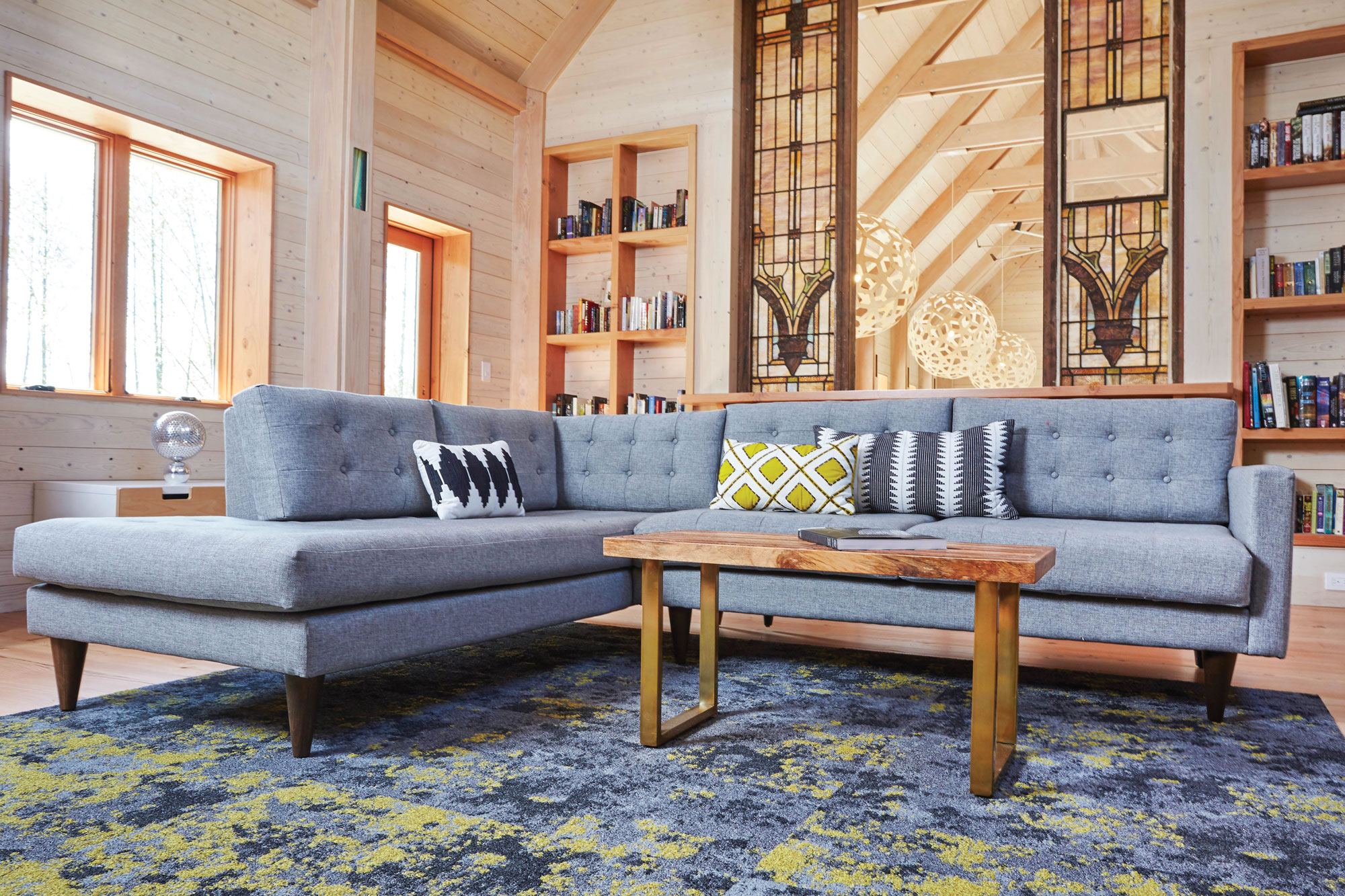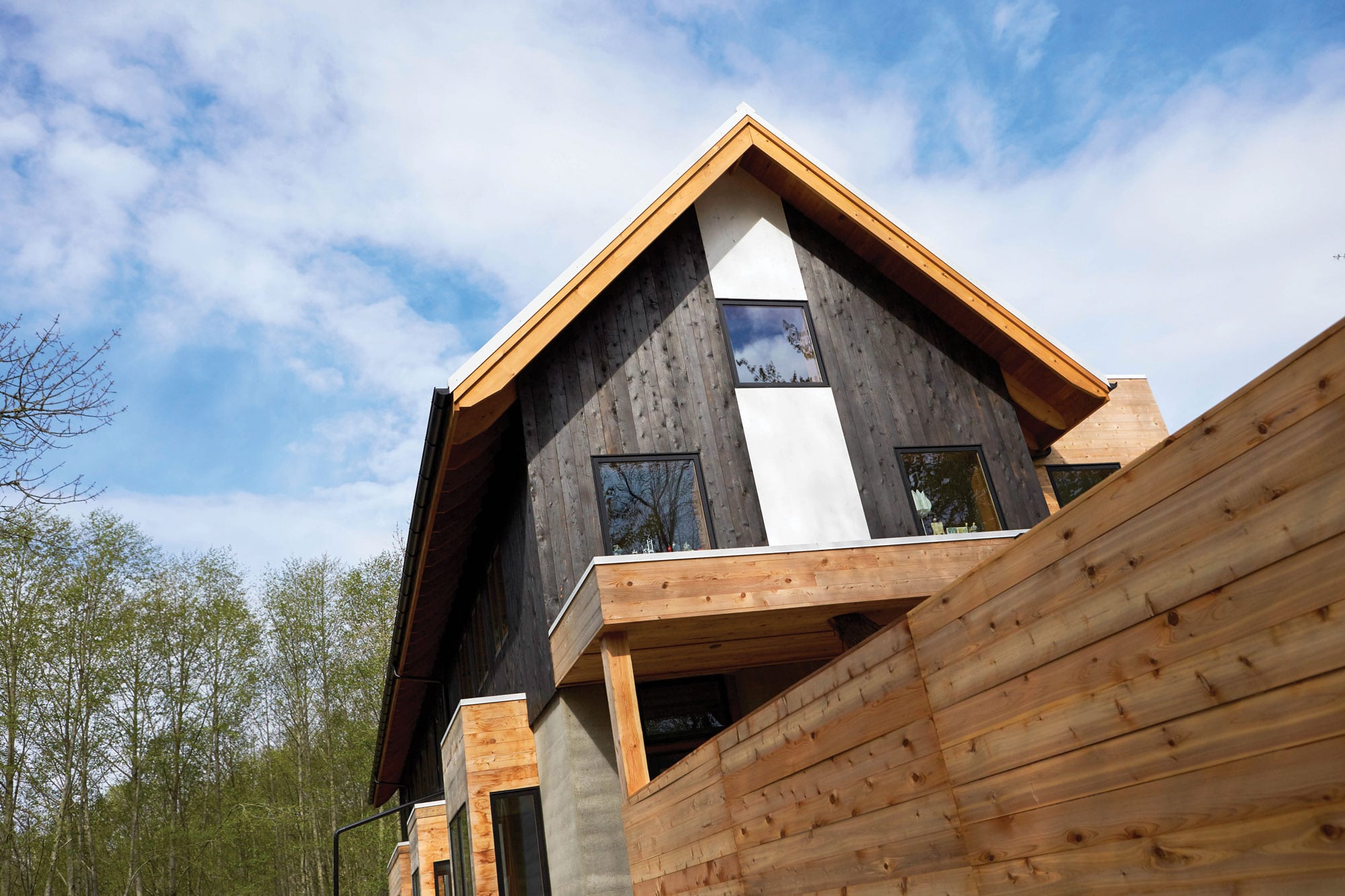
Jason McLennan’s Bainbridge Island house is a knockout example of a living home. [Photo: Daniel Banko]
In the cool beauty of the Pacific Northwest, Bainbridge Island is an oasis within an oasis. The Seattle bedroom community, dubbed by some the Nantucket of Washington, is one of the last spaces within ultra-tech Greater Seattle where a nature lover can get back to the land. Chicken coops reign, deer roam free, salmon jump with wanton abandon, and eagles occasionally dive-bomb duck ponds.
When green building superstar Jason McLennan, while walking a patch of the island that would become a piece de resistance de sustainability, found himself visited first by a crow, then by a frog, and finally by a heron, he knew he was home. Natural flora and fauna abounds, thanks to the site’s position on the sunny southern portion of Bainbridge and a previous landowner’s dedication to watershed restoration. “I really loved the idea of being part of a development area that has been made better by people, as opposed to being made worse,” McLennan says. “I’m delighted to be part of that.”
He was delighted, too, to have the opportunity to build a home for his family of five while showcasing the principles of sustainable building he advocates for every day. As chair of the board of the International Living Future Institute, CEO of McLennan Design, and as an award-winning architect and author, McLennan is no stranger to the tenants of green building and design. In 2012 he received the Buckminster Fuller Challenge Award and just last year received an Award of Excellence from Engineering News-Record magazine.

Interior siding from local cottonwoods plus countless other green features are encountered at every turn inside Heron Hall. [Photo: Daniel Banko]
With so many accolades under his belt, McLennan didn’t take the design of his family’s sanctuary lightly. After a couple years of planning, McLennan broke ground on his family home. Dubbed Heron Hall, the space has drawn the attention of designers, sustainability gurus, and locals since its 2-foot earthen walls were first rammed.
The 3,200-square-foot home incorporates the community tenants of open living spaces, swaths of natural light, and rooms designed to nurture connection and family. “The kids’ bedrooms open up into the family room directly. I really wanted to encourage sibling connections and family connections. There are different spaces, but they’re all open to each other.” Small bedrooms encourage McLennan’s three younger children to spend time in a shared family room. Tiny openings between bedrooms foster the Wes Anderson-ian vision of idyllic childhood antics. Outside, acres of Pacific Northwest scenery and a convenient walking distance to the local pool have created a South Bainbridge neighborhood kids’ hub. “That’s been kind of fun,” McLennan laughs. “We love the whole house. We use the whole house as we thought we would.”
That’s good news for a building that’s well on its way to becoming a certified residential Living Building—a standard of sustainability more rigorous than LEED and developed by McLennan and the Cascadia Green Building Council. The Living Building Challenge is based on more than specs. A space must demonstraate performance within seven sustainability areas, including water, energy, and materials, through 12 consecutive months of evaluation.

[Photo: Daniel Banko]
To that end: The home combines on-site construction with salvaged items. The double-height living space is structured by insulated rammed earth walls and south facing glass doors for energy efficiency and thermal mass. Upper level exterior walls feature the Japanese charred wood finish Yakisugi. Instead of drywall, the home has interior siding fashioned from the cottonwoods taken down at the building site (incidentally, cottonwoods were the only trees that had to be removed) and local Forest Stewardship Council–certified wood products. As a living building, it features composting toilets and a green roof system. A system of 10kW photovoltaic panels keeps the house and the family’s cars fully charged. The rainwater-only home uses a 15,000-gallon cistern for daily home water use and a 4-foot-deep agricultural cistern for landscaping and gardening. Materials and decorative elements are mostly local and mostly salvaged.
McLennan, wife Tracy, and three of four children—the fourth is living up his young adult years in Seattle proper—transplanted to Heron Hall in May. The family is still putting the finishing touches on their home, including landscaping. McLennan says he wants to go for Living Building certification when the family is more acclimated, and then to address each of the certification tenants in stages. Meanwhile, tours of Heron Hall, which numbered in the hundreds as construction was under way, have petered off, by design, as the family settles in.
“I’m happy with how people seem to respond to the house from all walks of life, whether they’re into sustainability or not,” McLennan says. “And that’s part of the goal: You can do stuff like super efficiency and composting toilets and it can still be really beautiful. It’s not weird. People can see it can be better. That’s part of the educational goal of the house.”
Meanwhile, the family is enjoying the sun and cool breezes of Seattle summer and fall from their porch, where herons strut their graceful bodies and, occasionally, eagles feel the need to terrorize the ducks. No worries, McLennan assures, the mama ducks are savvy.
A LIST OF RESOURCES
- Phoenix Composting
- Big Ass Fan Company
- Columbia Green
- Knauf Insulation
- Solarworld
- Sirewall
- Solar Design Associates
- Frederickson Electric
- Rainbank Rainwater Systems
- Prosoco
- Jeld-Wen
- Neil Kelley Cabinets
- Sustainable NW Wood
- Coyote Woodworks

[Photo: Daniel Banko]
